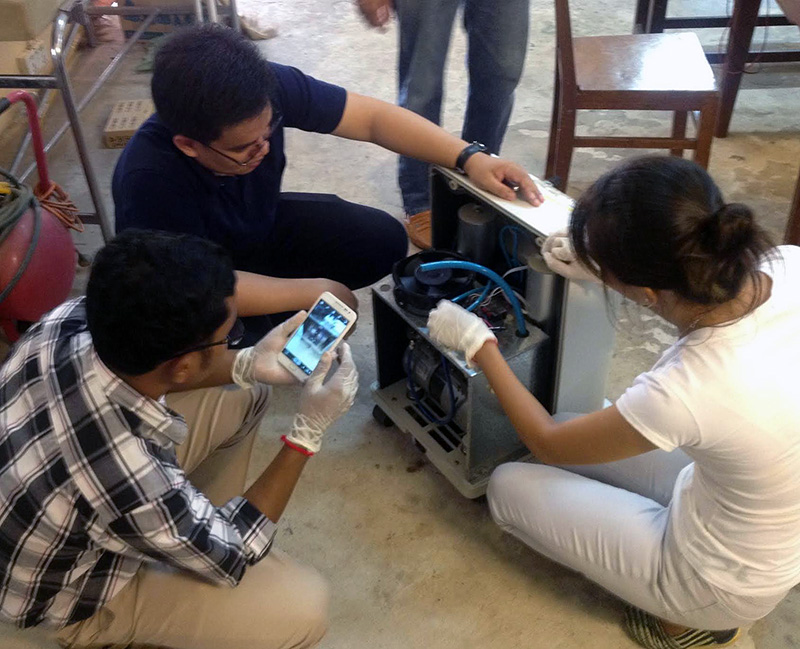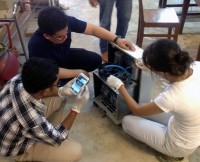Lack of Operational Medtech Equipment in Developing World

Up to 80% of medical equipment in the developing world is donated, but the World Health Organization and other researchers tell us that at any given time, 40–70% of equipment in developing world hospitals is not functioning. Instead of hospitals being well equipped with modern medical technology, they are burdened with piles and storerooms filled with unused devices. Between the donation and the junk heap, what’s going wrong?
A few things. Medical equipment manufactured in developed countries is designed for use in clean, climate-controlled environments that have reliable electricity. In low-income countries, however, machines are typically beset by power surges, intense heat, dust and humidity. The more delicate and sophisticated the machinery, the more likely it is to fall out of service. Even if a machine is operational, the instruction manual may be missing or may be in a language that no one at the hospital can read. Without anyone who can understand what a particular device is for or how it works, sometimes even new equipment is left uninstalled, taking up hospital space and helping no one.

These problems can be solved. Hospitals need trained biomedical equipment technicians (BMETs) to maintain and repair medical equipment to keep it in working order. BMETs also install new equipment and train hospital staff on how to correctly use equipment. With specialized training in healthcare technology management, BMETs provide a sustainable solution to keeping medical equipment functional. Did a power surge damage an incubator’s circuit board? A BMET can fix that. Is an anesthesia machine leaking? A BMET can troubleshoot that. Did a new dental chair come with installation instructions in German? A BMET can find the manual in other languages, contact the manufacturer, or research internet forums.
Unfortunately, very few such educational programs exist: One program, in Zambia, is run by THET, and the Amalthea Trust is working to train technicians in Uganda. In partnership with the GE Foundation, local hospitals, and technical schools, Engineering World Health (EWH) has created training programs in five countries—Rwanda, Honduras, Ghana, Cambodia and Nigeria—and just launched a new program in Ethiopia. We bring local BMETs up to international standards and train instructors so that we leave behind a self-sustaining educational program.
But the need for more BMETS remains great throughout the low-income world. We have public funders—the CDC , the United States President’s Emergency Plan for Aids Relief (PEPFAR), USAID —who invest tens of millions of dollars in medical laboratories and safe surgeries, but who do not yet see the necessity of trained BMETs to guarantee that those facilities remain operational after installation. In the absence of BMETs, so much of that expensive equipment is useless.
One barrier to funding is the difficulty of showing the direct impact of a BMET on public health outcomes. Researcher Robert Malkin at Duke University has shown, definitively, the marked increase—as much as 50%—of working equipment in a developing world hospital with trained BMETs as compared to a similar hospital without trained BMETs. But there are numerous variables between the fact of a piece of working equipment and the ultimate outcome for the patient: The skill of the doctor, and outside factors such as infection, patient non-compliance, etc. Yet, everyone acknowledges, intuitively, that a hospital with working equipment is superior to one without.
In the past, global health aid has (understandably) tended to emphasize the education of doctors and nurses. But donors need to go beyond investing in frontline health workers to make sure medical staff have the equipment they need to do their work. Blood samples can’t be analyzed for HIV, malaria or diabetes without lab equipment. Surgery can’t be done without sterilizers and anesthesia machines. The progression of pregnancies can’t be checked without ultrasound machines.
Not only do trained BMETs save lives, they save money. A hospital in Nigeria purchased five intensive care unit beds at a cost of $9,000. However, three of the beds broke down after the warranty had expired, and the vendor told them it would cost $6,500 to repair each bed. A team of EWH BMETs was able to redesign the beds’ control panels with a better power supply, new fuses and simpler controls for a total cost of $275. Think of what the hospital can do with the $19,000 it saved!
Training BMETs also empowers people within the community, giving them pride in their work. Leopoldo Zelaya, a student in EWH’s Honduras training program, said this type of professional training “generates for the country young skilled workers who are highly qualified…producing skilled workers and captivating and inspiring young people.”
The GE Foundation has been ahead of the curve, as they have worked to improve access to safe surgery and strengthen hospital infrastructure for years. However, we need more targeted support to build workforces of certified BMETs in more countries and to develop local training programs that can continue to feed the pipeline with local technicians. Donations of equipment alone do not create sustainable change: Training a technical workforce does.
As Leopoldo Zelaya says, “Training is an investment that tomorrow will bring benefits to everyone.”